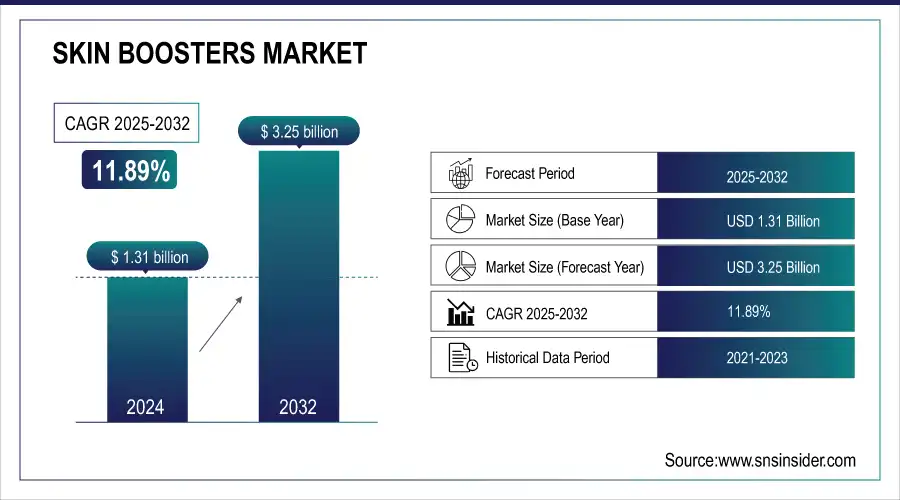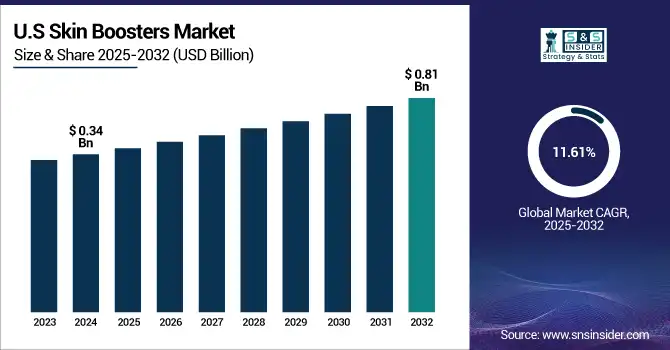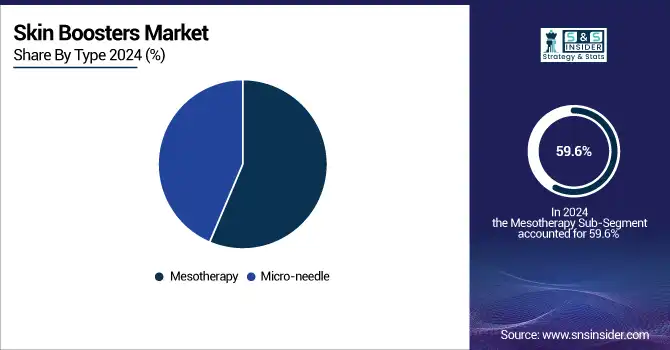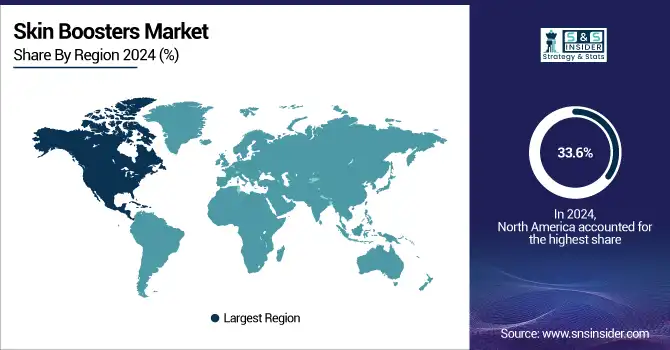Skin Boosters Market Report Scope & Overview:
The Skin Boosters Market size was valued at USD 1.31 billion in 2024 and is expected to reach USD 3.25 billion by 2032, growing at a CAGR of 11.89% over the forecast period of 2025-2032.
The growing demand for non-invasive aesthetic treatments that improve skin hydration, elasticity, and smoothness is driving the robust growth of the global skin boosters market. Product adoption is heavily driven by rising consumer awareness, along with the presence of a large and aging population, and the growing popularity of preventive skincare. Further stimulating market growth are advances in formulations, such as boosters based on hyaluronic acid and exosomes, and an expanding range of medspa services around the globe. The growing desire for translucent, younger-looking skin continues to drive both professional and at-home skin booster treatments.

To Get more information on Skin Boosters Market - Request Free Sample Report
The U.S. skin boosters market size was valued at USD 0.34 billion in 2024 and is expected to reach USD 0.81 billion by 2032, growing at a CAGR of 11.61% over the forecast period of 2025-2032.

North America dominated the skin booster market, with the U.S. leading owing to larger aesthetic infrastructure, higher devotion toward aesthetic excellence, and increasing awareness about skin rejuvenation treatments. The presence of key market players and the growing number of FDA approvals for novel injectable products further support the dominance of this country in the regional landscape.
Market Dynamics:
Drivers:
-
Expansion of the Market is Attributed to Increasing Demand for Minimally Invasive Aesthetic Procedures
One of the major driving factors for the global skin boosters market growth is the paradigm shift towards non-invasive procedures globally. Skin boosters are a less invasive, low-risk, low-downtime, and more natural result alternative to surgical facelifts or extensive dermatological procedures. This factor draws a more diverse clientele, including first-time appetite new aesthetic patients. This trend is evident in the rise of injectable applications such as hyaluronic acid-based boosters for what are primarily more efficient anti-aging, revitalizing, and cover-enhancing solutions for people with busy lifestyles who do not want to interrupt their daily rhythm too much.
-
Growth of the Global Skin Booster Market is Majorly Attributed to the Technological Advancement in Formulations of Skin Booster
Modern advancements in skin booster technology have led to the development of products that offer longer-lasting and more visible results. Recent innovations, including cross-linked hyaluronic acid, PDRN (polydeoxyribonucleotides), and bioactive compounds such as exosomes, enhance rehydration, collagen stimulation, and skin regeneration. These developments improve effectiveness, but also enhance patient experience and treatment outcomes. The ongoing investments and R&D in personalized skin care are also encouraging companies to offer products as per the needs of the target population, contributing to product diversification and market growth.
Clinical studies published in Dermatologic Surgery and at the Mayo Clinic have found enormous improvements in skin hydration, firmness, wrinkle improvement, and anti-inflammatory effects by using exosome-based treatments either topically or after microneedling.
Per Byrdie, media coverage showcases exosomes and PDRN at "the most fashionable, probably the most game-changing skincare substances of 2025," showcasing the passion of shoppers and industries for regenerative substances.
Restraints:
-
Short-term Results Requiring Repeat Procedures are Restraining the Market from Growing
The duration of action for most skin boosters, especially those based on hyaluronic acid (HA) or PDRN, is 3 to 6 months, depending on the skin type, metabolism, and lifestyle of the patient. This means patients must come in for several sessions a year to keep benefits such as improved skin hydration, elasticity, and appearance, nice and glowy.
The repetitive cycle of treatment raises cost and time involvement, which may discourage consumers with price or time sensitivity. Moreover, the perceived hassle of frequent touch-ups may push potential users to longer-lasting options, limiting the broader acceptance of skin boosters.
Segmentation Analysis:
By Type
The mesotherapy segment dominated the skin boosters market share with 59.6% in 2024 and is expected to show the fastest growth throughout the forecast period, attributable to long-standing experience of use coupled with a simple, minimally invasive and effective approach for skin rejuvenation, along with high consumer confidence in providing observable skin rejuvenation results. Mesotherapy is a treatment that uses microinjections of vitamins, enzymes, and hyaluronic acid just below the skin to improve skin hydration, elasticity, and glow. Due to it can be applied instantly, it has customized treatment plans, and it is highly popular in dermatology clinics and medspas.
Due to the increasing demand for at-home devices and popularity among the younger generation, the micro-needle segment will grow significantly throughout the forecast period. Microneedling improves skin texture and induces collagen through micro-injuries; the treatment results are greatly enhanced when skin boosters, such as hyaluronic acid or exosomes are used in combination. The non-invasive aesthetic procedures that can be performed quickly at the clinic and have a faster recovery time are becoming more popular as they are a more practical and economical alternative for patients, thus facilitating the rapid uptake in clinical settings and in-home care.

By Ingredient
By Ingredient, the Hyaluronic acid (HA) segment held the largest share of the skin boosters market with around 55.4% market share due to its clinically proven effectiveness, well-established safety, and acceptance in a variety of medical dermal fillers. HA is a naturally existing material that draws moisture to the skin. It is a great choice for providing hydration and adding volume. The cosmetic market is driven primarily by the enhanced biocompatibility and visible findings in no time. In addition, several product launches and FDA-cleared formulations, such as SKINVIVE by JUVÉDERM, have established HA as the gold standard in skin booster actives across the globe.
Based on Ingredient, the Polydeoxyribonucleotides (PDRN) segment is estimated to show the fastest growth during the forecast period, due to increasing consumer interest in and demand for regenerative aesthetics and cellular repair therapies. PDRN (Polydeoxyribonucleotide) is a DNA extracted from salmon, which can help stimulate the regeneration of damaged tissues and reduce inflammation and provide better skin elasticity through stimulation of the fibroblasts. PDRN-based skin boosters are quickly gaining traction among dermatologists and aesthetic practitioners due to a significant number of published clinical studies confirming their skin rejuvenating effects, and the greater popularity of non-HA alternatives in Asian and European markets.
According to ScienceDirect, PDRN (polydeoxyribonucleotide) is well documented in human clinical studies and scientific reviews to stimulate collagen production, see an increase in tissue regeneration, and improve skin elasticity.
By Gender
The female segment dominated the skin boosters market share with 74.15% in 2024, with high aesthetic awareness and high demand for non-invasive skin rejuvenation treatments. While women have largely always been the main market for cosmetic procedures, including skin boosters for anti-ageing and hydration, Derma clinics and medspas catering to female choices have boosted the availability of individualized treatment regimens, in part supporting this trend. Strong uptake in female patients globally was also fueled by social media influence, beauty standards, and demand for youth skin.
The fastest growth is anticipated in the female segment during the forecasted period due to the rising awareness of the benefits of early aesthetic interventions among younger women, increased access to cosmetic dermatology services, and the emergence of aesthetic treatments as an acceptable part of the culture within developing markets. Moreover, there is an increase in demand for skin boosters aimed at female skincare targets due to the rising inclination of working women and urban populations towards skin health and aesthetics.
By End-Use
Due to the increased demand for minimally invasive cosmetic procedures performed in a relaxing, spa-like environment, the 2024 skin boosters market is dominated by the Medspas segment. A medspa combines the best of medical professionals and luxurious pampering, which brings you an enticing combination for the consumer who values quick and comforting services. Coupled with the abundance of highly skilled medspa practitioners, around-the-clock, customized skin booster packages, the medspa is fast becoming the hot spot destination for working professionals and beauty aficionados requiring an express skin pampering session.
The dermatology clinic segment accounts for the significant growth, owing to increasing demand among patients for clinically directed, evidence-based skincare treatment. In cases, where skin conditions can be exacerbated by environmental factors or for treatment plans that need to be individualized to a particular patient, dermatology clinics are more credible and clinically feasible. The demand for advanced skin booster therapies is primarily driven by the increasing awareness regarding skin health and aesthetic procedures globally, resulting in skin clinics expanding their services to offer skin booster therapy, enabling rapid segment growth.
Regional Analysis:
Skin boosters market trend is dominated by North America with a 33.6% market share due to the high prevalence of adopting any aesthetic-related procedures, along with strong healthcare infrastructure and a high awareness level of consumers pertaining to skin rejuvenation non-invasive treatment. The presence of key manufacturers and brands is contributing factors, and the availability of high-end dermal fillers and skin boosters in the region has been stimulating the growth of the market in the region. North America, this region holds a major market share expected to continue to maintain its leadership during the forecast period, owing to a strong regulatory framework, the highest disposable incomes, and high demand for anti-aging solutions.

Get Customized Report as per Your Business Requirement - Enquiry Now
The fastest growing region for the skin boosters market is Asia Pacific with 12.70% CAGR over the forecast period, which is driven by an increase in demand for cosmetic procedures, an increase in the middle-class population, increase in interest in young skin among consumers. Nations, such as South Korea, China, and Japan are becoming significant centers for aesthetic medicine, driven by medical tourism and the fast growth of dermatology centers and medspas. In addition, cultural factors, such as appearance and beauty trends circulating on social media push demand further in this area.
Europe accounts as the second largest region in the skin boosters market analysis owing to the presence of aesthetic medicine practice, a ripe network of dermatology clinics, and consumer tradition demanding anti-ageing and skin enhancement solutions. Rising acceptance of minimally invasive cosmetic procedures in the region, along with regulatory approvals and a higher number of certified practitioners within the region, contributes to the growth of the U.S. and Canadian regions. Moreover, an increase in disposable income and medical tourism in France, Germany, and Italy strengthens the market share of Europe due to increasing awareness regarding skin health and wellness.
Skin boosters market in Latin America and the Middle East & Africa (MEA) is anticipated to grow moderately, owing to increased awareness related to aesthetic treatments and gradual improvement of healthcare infrastructure. A growing middle class and a cultural inclination towards beauty enhancements are some of the factors driving the growth in demand for non-invasive cosmetic procedures in Latin America, especially in major economic countries. Market growth is hindered by a lack of access to advanced technologies and the high costs associated with certain solutions.
Demand for aesthetic treatments is increasing in the MEA region, particularly in Gulf countries where the population consists of more youths who are image-conscious, and cosmetic tourism is driving the skin boosters market trend. Despite this, growth continues to be subdued overall, as access to procedures remains unequal between urban and rural locations, and premium skincare approaches are costly.
Key Players:
The skin boosters market companies are Revance Therapeutics, Allergan Aesthetics (AbbVie), Galderma, Teoxane Laboratories, Merz Pharma, Revive Pharma, Laboratoires Filorga, Croma-Pharma, BioScience, RegenLab, Caregen, Haohai Biological Technology, Bloomage Biotechnology, Cytocare (Revitacare), Anika Therapeutics, Prollenium Medical Technologies, Dermedics Laboratory, Hugel, Medytox, IBSA Institut Biochimique, and other players.
Recent Developments:
-
June 2025 – AbbVie's subsidiary, Allergan Aesthetics, stated that the U.S. Food and Drug Administration (FDA) has accepted for review its supplemental premarket approval (sPMA) application for SKINVIVE by JUVÉDERM. The application requests approval to treat neck lines and restore the appearance of the neck. SKINVIVE by JUVÉDERM is currently approved in the U.S. to improve the smoothness of cheek skin in adults 21 years and older.
-
January 2025 – Galderma announced encouraging interim results from a groundbreaking clinical trial assessing the combination of Restylane Lyft or Contour with Sculptra for patients who suffer from facial volume loss as a result of weight loss caused by medications. The three-month interim data show that the combination therapy strongly improved facial appearance and was highly rated by patients for satisfaction.
Skin Boosters Market Report Scope:
Report Attributes Details Market Size in 2024 USD 1.31 Billion Market Size by 2032 USD 3.25 Billion CAGR CAGR of 11.89% From 2025 to 2032 Base Year 2024 Forecast Period 2025-2032 Historical Data 2021-2023 Report Scope & Coverage Market Size, Segments Analysis, Competitive Landscape, Regional Analysis, DROC & SWOT Analysis, Forecast Outlook Key Segments • By Type (Mesotherapy, Micro-needle)
• By Ingredient (Hyaluronic Acid (HA), Polydeoxyribonucleotides (PDRN), Poly-L-Lactic Acid (PLLA)/Poly-D,L-Lactic Acid (PDLLA), Polycaprolactone (PCL), Exosomes)
• By Gender (Female, Male)
• By End Use (Dermatology Clinics, Medspas)Regional Analysis/Coverage North America (US, Canada, Mexico), Europe (Germany, France, UK, Italy, Spain, Poland, Turkey, Rest of Europe), Asia Pacific (China, India, Japan, South Korea, Singapore, Australia, Rest of Asia Pacific), Middle East & Africa (UAE, Saudi Arabia, Qatar, South Africa, Rest of Middle East & Africa), Latin America (Brazil, Argentina, Rest of Latin America) Company Profiles The skin boosters market companies are Revance Therapeutics, Allergan Aesthetics (AbbVie), Galderma, Teoxane Laboratories, Merz Pharma, Revive Pharma, Laboratoires Filorga, Croma-Pharma, BioScience, RegenLab, Caregen, Haohai Biological Technology, Bloomage Biotechnology, Cytocare (Revitacare), Anika Therapeutics, Prollenium Medical Technologies, Dermedics Laboratory, Hugel, Medytox, IBSA Institut Biochimique, and other players.

